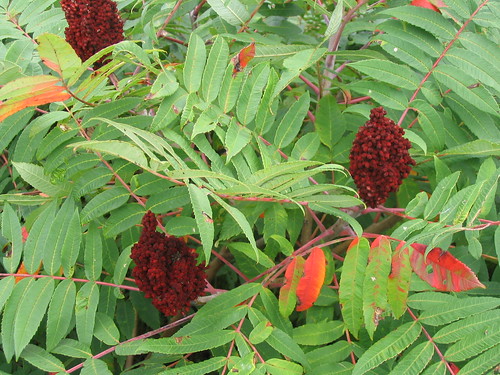 Lemonade is a major staple in our household over the summer months. For a special treat, we make lemonade without lemon juice -- we brew it from lemony sumac berries.
Lemonade is a major staple in our household over the summer months. For a special treat, we make lemonade without lemon juice -- we brew it from lemony sumac berries.There are actually several varieties of sumac in our area. All get extremely distinctive clusters of dark red, hairy berries in the late summer. And they all have pinnate leaves (multiple leaflets on a stem form the larger leaf) that turn gorgeous shades of red to purple in the fall.
Rhus typhina, staghorn sumac, is the giant of the genus, growing up to 25 feet tall. It has fuzz on the stems very much like the fuzz that covers new antlers on a deer. Rhus coppalina, shining or winged sumac, has "wings" on its stems; Rhus glabra, or smooth sumac, has smooth (not winged or fuzzy) stems. And the distinguishing characteristic of Rhus aromatica, or fragrant sumac? Its leaves have a distinctive odor when crushed.
 Worried about poison sumac? It's actually an unrelated shrub (Toxicodendron vernix) that is not very common in the DC area. Its berries are white, so it is not likely that you will confuse it with non-poison sumac if you are out looking for red berries. But you're right to worry -- it will give you a rash, just like its much closer relative poison ivy (Toxicodendrum radicans).
Worried about poison sumac? It's actually an unrelated shrub (Toxicodendron vernix) that is not very common in the DC area. Its berries are white, so it is not likely that you will confuse it with non-poison sumac if you are out looking for red berries. But you're right to worry -- it will give you a rash, just like its much closer relative poison ivy (Toxicodendrum radicans).To make sumac lemonade, cut off a few heads of berries with some garden clippers. Soak them in a half-gallon of water for half an hour or more. This will leach out the ascorbic acid (Vitamin C) and its lemony flavor, along with enough color to give you pink lemonade. You can crush the berries a little with your hands to help the process along. There's a sweet spot you're looking for -- too little soaking won't give enough flavor, but too much will start to leach out the tannins and make your lemonade taste more like tea. Pour the liquid through a strainer to get out the hairs, then sweeten to taste.
 There's one catch: just like the lemony goodness of the sumac berries will leach out into your pitcher of water, it will leach out in the rain. So you may find lovely bunches of sumac berries that have very little flavor. Before picking, take a little taste test of one of the berries. It should be noticeably tart. If not, look for another bunch -- preferably one that's been more sheltered from the rain.
There's one catch: just like the lemony goodness of the sumac berries will leach out into your pitcher of water, it will leach out in the rain. So you may find lovely bunches of sumac berries that have very little flavor. Before picking, take a little taste test of one of the berries. It should be noticeably tart. If not, look for another bunch -- preferably one that's been more sheltered from the rain.In the wild: Sumac is very common in the DC area. We see it most frequently on roadsides -- it likes the sun. All four varieties of sumac native to our area are growing around Lake Artemesia -- take an ID book and see if you can find each species! The berries are good food for birds, so please don't take too many heads of sumac, and be sure to use whatever you do pick. Also be sure not to pick in a park that doesn't allow it.
In your yard: Sumac has a reputation for being very aggressive -- it spreads by underground roots and can take over an area. Which makes it great for roadsides, but not so much in your yard -- unless you have a lot of space.
Like the photos in this post? Mouse over for credits; a click takes you to the photographer on Flickr.


